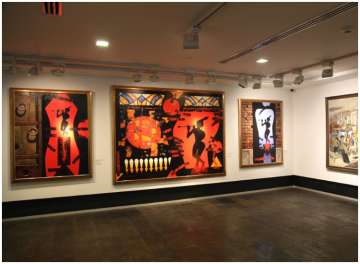Traditional ‘Ektaras' and 'Bapangs' crafted from dried vegetables, paintings of colourful Banjara turbans and sketches documenting nomadic kitchens in Rajasthan are on view at a gallery space here, depicting the lives of the state's nomadic communities.
Held at the Art Spice Gallery in New Delhi, "Romancing Nomadism" displays nomadic artefacts; traditional Morpankhi weaves, musical instruments, weapons, utensils, and visual documents.
According to the curators, it showcases artefacts from Maru Banjara, Bhopa, Jogi, Gadia Lohar, Kalbeliya and Bawariya communities from Rajasthan.
Along with Babita Gupta, it has been co-curated by Chinh India Trust, which is run by filmmakers Minakshi and Vinay Rai, who said they have been working with the communities on media literacy since early 2000s.
"Nomadic communities in the Indian subcontinent have displayed an amazing tolerance for Mughals and the East India Company. They, however, started to be penalised all over the world when urban civilisations started settling, nations' boundaries started to be fixed, and the concept of ‘address' came into existence," Minakshi Rai told IANS.
Nonetheless, many free-spirited nomads, often called Banjaras managed to live their lives on the go.
The exhibition, although not a comprehensive resource on nomadism, introduces a slice of the everyday life inside nomadic communities of the state.
Artist Sanjay Soni's photorealist paintings of Banjara men staring intently at the viewer, also reveal a deeper stratification.
"If you see the colours of the turbans (yellow, burgundy red, and green) they actually reveal a certain hierarchy within the nomads. During our work, we found that the Banjara tribes, who don green turbans, eat before everyone else, and nobody eats till they have finished," Rai explained.
Also featuring in the exhibition are musical instruments ‘Bapang' -a string instrument made from goat skin, and ‘Ektara' -another string instrument with its base traditionally moulded from dried pumpkin.
On close view, one can link the origin of these instruments from a larger nomadic ideology, that of sustenance and utilising what is available.
"The nomad ideology is that of need, not of greed," Rai said, stressing on the essential frugality that is inherent in nomadism.
Other highlights of the show are exhibits of vivid Morpankhi (peacock stitch) embroidery, prepared by community members and generally used for bridal clothing, and pencil sketches of Banjara kitchens that now accommodate modern utensils like thermoses, along with ‘Kadahis' and tumblers.
The exhibition is open for public viewing at the Art Spice Gallery (The Metropolitan Hotel) till October 25.
(IANS Inputs)
For latest Lifestyle updates, check out our Facebook page!
